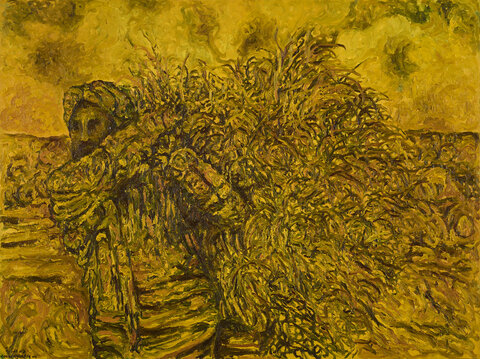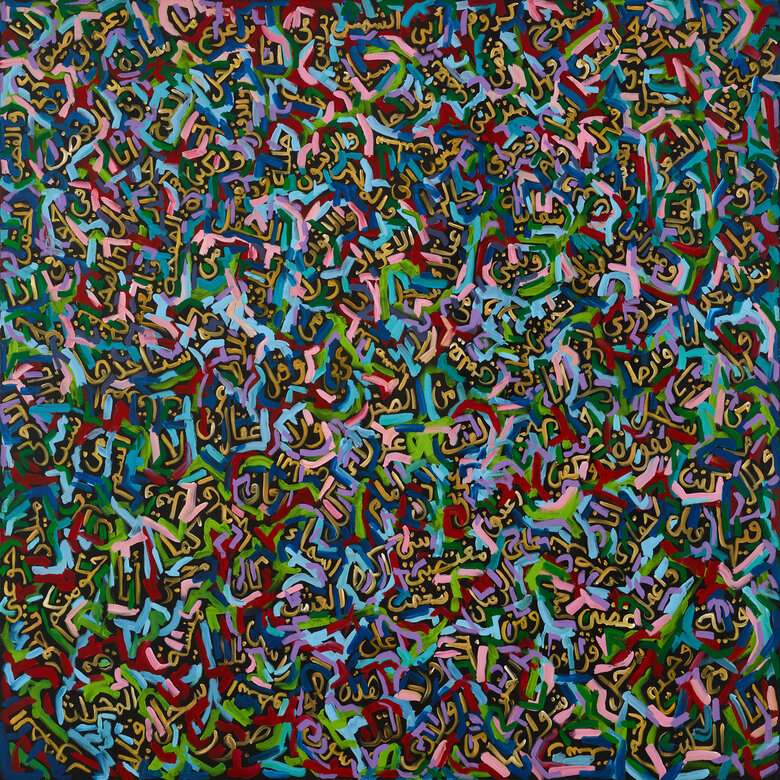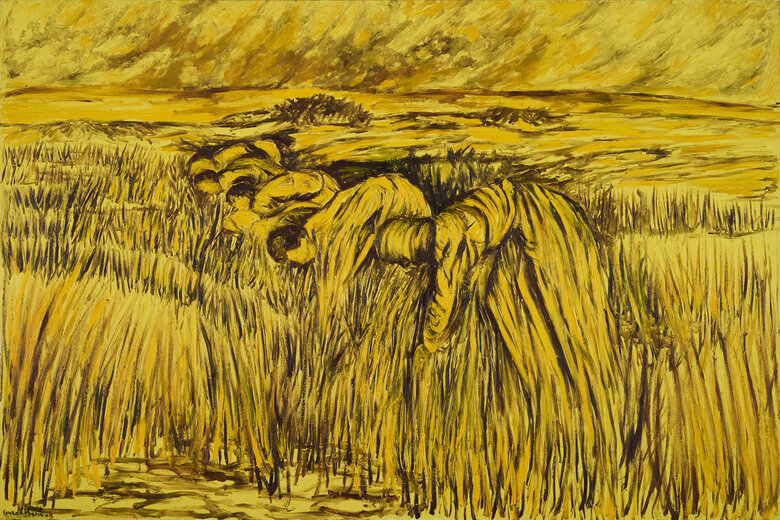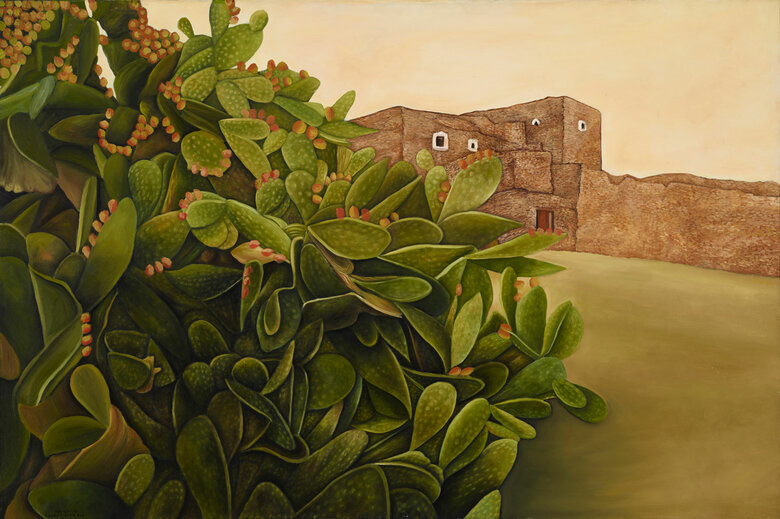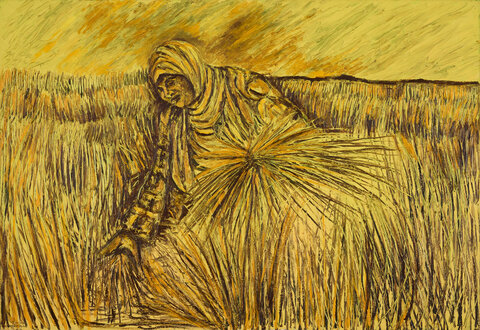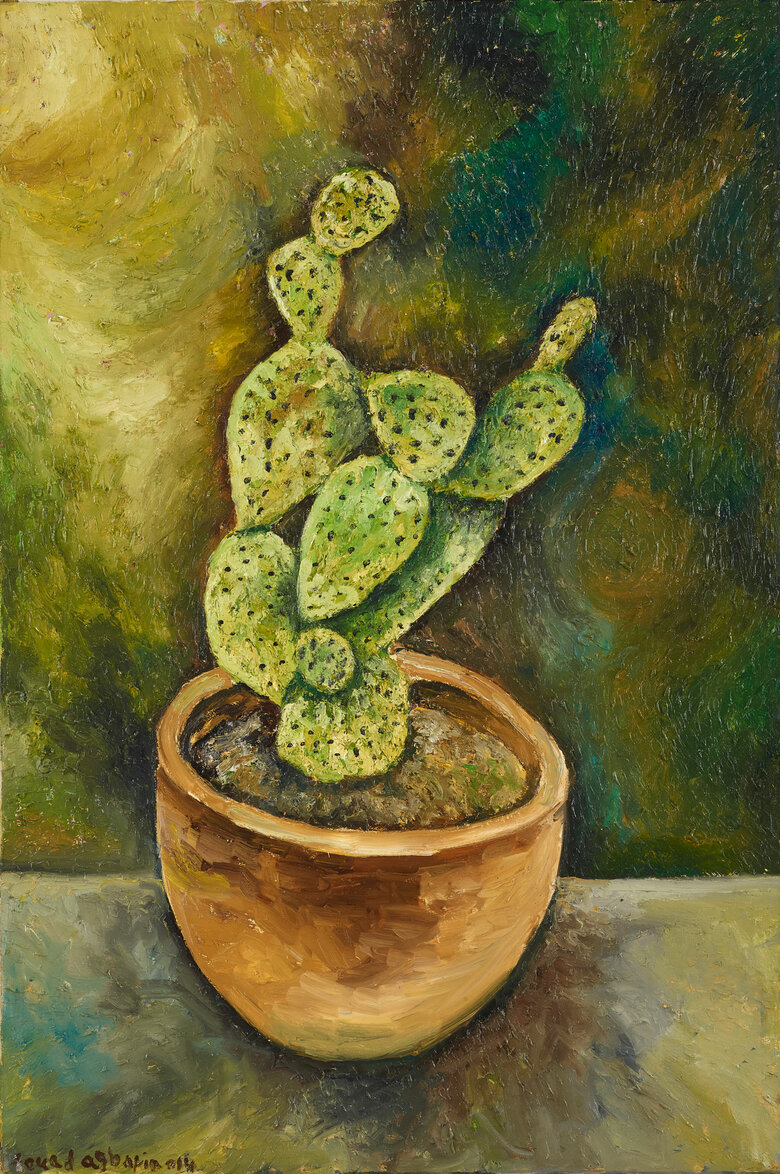Fouad Agbaria was born in 1981 in the village of Musmus near Umm El Fahm, Palestine.His mother was an educated housewife, and his father, a Hebrew language tutor. As a child, he enjoyed...
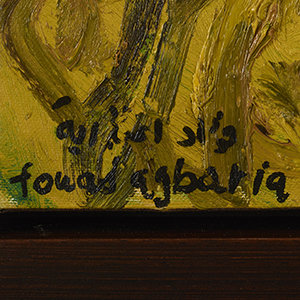

FOUAD AGBARIA, Palestine (1981)
Bio
Written by WAFA ROZ
Fouad Agbaria was born in 1981 in the village of Musmus near Umm El Fahm, Palestine.His mother was an educated housewife, and his father, a Hebrew language tutor. As a child, he enjoyed family gatherings in a household of love and compassion and listened to his grandparent’s stories. Growing up in a village, he accompanied his grandfather to the orchards, the olive groves, and the meadows of Musmus, where he observed olive picking, wheat harvesting, and the gathering of wild plants, among other activities. Given his humble origins, Agbaria struggled to meet his dream of becoming an artist. While still a student in Jerusalem, he taught in schools in the towns of Jawarsih in Ramleh, Eisawiyeh in East Jerusalem, and Abou Ghosh on the Tel Aviv-Jerusalem highway in order to cover his tuition fees. Agbaria earned his BA in fine arts from Bezalel Academy in West Jerusalem in 2004, and an MA from Haifa University in 2014.
Palestinians living in Israel are second-class citizens, restricted to specific geographical, social, economic, and political spaces. Umm El Fahm lies within Israeli borders, and as a Palestinian living there, Agbaria was part of a marginalized community; naturally, this environment influenced his art. Nostalgia was central to his early work, in which he deploys themes from his past to both confront a disappointing present and advocate for an alternate future. Weaving the personal and the political in works inspired by his childhood, Agbaria provides a heartfelt perspective on the Palestinian struggle.
Agbaria made his international debut in 2006 when he participated in the group exhibition Equal and Less Equal alongside acclaimed artists such as Sebastiao Salgado and Andreas Gursky. Put on by Jerusalem’s Museum on the Seam, so named because it straddles East and West Jerusalem, the exhibition addressed the discrimination and exploitation facing workers in the era of late capitalism. Worker (2002), portrays the Palestinian laborer in Israel, who is inevitably underpaid and deprived of basic social welfare. The oil on canvas painting features a man against a blank white background; he is seated, but he lacks a chair. The worker’s position is unstable and strenuous – despite the repose suggested by a seated position, he alone supports the weight of his body – and expresses a loss of place and identity, as well as financial security.
Agbaria revisited themes common to the Palestinian nationalist iconography popular in the early 1980s. In an attempt to revive places from the past, his first solo exhibition, Visual Memory (2012), showcased oil paintings and lithographic prints depicting deserted places, rural settings, landscapes, and cactus hedges. For instance, Cactus in the Village (2010) depicts a landscape haunted by human absence. A huge cactus plant with dense green oval leaves occupies nearly half the width of the canvas, while an old stone house rests in the background in a depopulated rural area. Drawing from artist Walid Abu Shakra (1946-2019), Agbaria re-introduces the cactus as the village’s marker and one that outlives its exiled inhabitants. Indeed, in many of his works, Agbaria re-appropriates the sabra, also known as the prickly pear cactus,which has been used for decades by Palestinian artists as a symbol of endurance and resilience. Artists of the Abu Shakra family are primarily known for their cactuses; in addition to Walid, Asim Abu Shakra (1961-1990) painted potted cacti to convey the sense of isolation he felt as a Palestinian in Israel, and these images are echoed in Agbaria’s simplified, geometrical renderings of cactus leaves. With Karim Abu Shakra, Agbaria launched a 2016 joint exhibition, Bond, that featured paintings of blossoming potted cacti in vibrant colors. The paintings shown in the exhibition demonstrate Agbaria’s development of a post-impressionist style, with mid-scale paintings dominated by broad swaths of bright color as well as pointillist brushstrokes and gradated washes.
Fouad Agbaria’s rural genre scenes portray pre-Nakba Palestine as an idealized, abundant agrarian culture, rich in communal identity. For example, The Earth’s Embrace (2012) portrays a peasant woman joyfully picking wheat stalks from the field. In Masculine Harvest (2012), a male peasant forcefully pulls wheat bundles with a pitchfork. The pointed difference between these paintings suggests the rigid gender roles often found in traditional rural cultures, with the woman smiling and maternal while the man demonstrates strength and virility. Reminiscent of Jean-François Millet’s iconic The Gleaners (1857), Agbaria’s Field for Harvest (2012-2013) depicts peasants bending to pick up harvest crops. Agbaria’s paintings look realistic, but unlike the accurate likeness depicted by Millet, he only captures the impression of an image. The fact Agbaria painted his figures with brisk brush strokes, they lack realistic detail. Peasants, fields, and trees become patches of color. These patches, objects in their own right, transform into figureless expressionistic abstractions exemplified in Harvest (2014).
During his early childhood, Agbaria eagerly awaited the broom maker’s visits to the village of Musmus: he loved to watch him craft his brooms with a needle and a yarn of straw and to observe his bizarre tools. This encounter was inspirational for the artist, who developed a style of spikey brushwork that mimicked interwoven straw.
The artist’s harvest scenes blend the colors of the landscape - a warm yellow-brown summery palette – with those of the characters that populate them. Mirroring Vincent van Gogh’s post-impressionistic painting technique, Agbaria brightens his colors and loosens his brushwork, alternating broad and fine brush strokes onto the thick oil paint, and occasionally using a palette knife to apply thick layers of paint to the canvas.
In his more recent works, Agbaria establishes an abstract style focused on Arabic calligraphy and floral ornamentation, creating freestyle calligraphic scripts in acrylic on canvas. The verses he illustrates are usually drawn from the Qur’an, the work of famous Palestinian liberation poet Mahmoud Darwish, or Agbaria’s writings. A colorful pattern of brushstroke arcs and lines surround the letters and scripts that are inscribed in luminous gold, white, or blue paint. This luminosity symbolizes omnipotence and divinity, aligning itself with what is traditionally considered “Islamic art” while reflecting a contemporary cultural and artistic identity.
Fouad Agbaria was studying the history of carpet-making in the Middle East when he began Weaving and Cracks (2017-2018), a series of large-scale oil paintings on canvas that depict carpets adorned with floral and arabesque details. The carpets themselves call to mind pride in craftsmanship and cleanliness, as in the Arab world, these textiles occupy domestic and religious spaces. For Muslims, carpets draw additional religious associations due to the custom of prayer rugs, which serve to protect the supplicant from the dirt of the floor and keep her or him clean while she or he prays. Atop each of Agbaria’s carpets, however, the artist paints battleships, tanks, car tires, children’s toys, or playground slides, mixing these associations with symbols of war and everyday life. These paintings thus evoke his childhood in a troubled homeland, juxtaposing past and present, innocence and destruction, war, and peace. One of his latest works, Survival (2018), showcased in the 2019 group exhibition Even the Trees Bleed, again features a resilient cactus growing on concrete. The exhibition tells a story of man’s expropriation and exploitation of nature as well as of his fellow man, a reality that fuels Agbaria’s artistic creation.
Married to his teenage sweetheart, Agbaria continues to live and work in Umm -El Fahm, Palestine.
Sources
Abdi, Abed. Visual Memory, ed. Isaac Komen.Umm-El Fahm, Um El Fahem Gallery,2012.https://issuu.com/orientationproductions/docs/fuad
Art, Kiyan. "Bond: Kiyan Art." Artsy. March 31, 2017. Accessed July 16, 2019. https://www.artsy.net/show/kiy...
and Less Equal: מוזיאון על התפר ירושלים: MUSEUM ON THE SEAM: Jerusalem." MOSEUM ON THE SEAM. Accessed July 16, 2019. https://www.mots.org.il/equal-and-less-equal.
"Even the Trees Bleed: מוזיאון על התפר ירושלים: MUSEUM ON THE SEAM: Jerusalem." MOSEUM ON THE SEAM. Accessed July 16, 2019. https://www.mots.org.il/even-the-trees-bleed.
"Fouad Agbaria (Exhibition) Archives." Zawyeh Gallery. Accessed July 16, 2019. https://zawyeh.net/category/pastexhibitions/fouadagbariaexhibition/.
"Fouad Agbaria: Palestinian Artist." Zawyeh Gallery. June 24, 2019. Accessed July 16, 2019. https://zawyeh.net/fouadagbaria/.
Irving, Sarah. "Painter Fouad Agbaria Reclaims Symbols of Palestine's Survival." The Electronic Intifada. February 12, 2017. Accessed July 16, 2019. https://electronicintifada.net/blogs/sarah-irving/painter-fouad-agbaria-reclaims-symbols-palestines-survival.
"Meet the Artists." "Rest in My Shade". https://www.restinmyshade.com/meet-the-artists/.
Mleahat, Sulieman. Nostalgia to the Light. Ramallah, Zawyeh Gallery,2015.
https://issuu.com/ummelfahem-gallery/docs/list_of_works-_nostalgia_to_the_lig
Nasrallah, Aida.Back to Open Spaces. Kibbutz Bee’rie: Bee’rie Gallery,2014.
http://www.gallerybeeri.co.il/wp-content/uploads/2014/03/CATALOG_FOUAD.pdf
"Nostalgia to the Light by Fouad Agbaria." Zawyeh Gallery. March 11, 2019. https://zawyeh.net/nostalgiatothelight/.
Palestinian Artist Fouad Agbaria Opens Latest Exhibition: Weaving and Cracks. Accessed July 16, 2019. http://palestinemonitor.org/details.php?id=x7v4gfa20534y03rdg2jud.
Productions, Orientation, and Orientation productions. "Visual Memory." Issuu. https://issuu.com/orientationproductions/docs/fuad.
CV
Selected Solo Exhibitions
2019
Weaving, University Gallery, Ben Gurion University of The Negev, Be'er Sheva, Occupied Palestine
2018
Fouad Agbaria, Maps Of Memory, Curator: Varda Steinlauf, Umm El Fahem Gallery, Umm El Fahem, Occupied Palestine
Weaving and Cracks, Zawyeh Gallery, Ramallah, Occupied Palestine
2015
Nostalgia to the Light, Curator: Suleiman Mlihat, Zawyeh Gallery, Ramallah, Occupied Palestine
Between the Overt and the Covert, Curators: Yonit Kadosh and Miri Werner, Ramot, Menashe Art Gallery, Occupied Palestine
2014
Between the Personal and the Political, Curator: Manar Zoabi, Al-Bir Association Gallery, Arara village, Occupied Palestine
Back to the Open Spaces, Curator: Ziva Yalin, Kibbutz Beeri Art Gallery, Occupied Palestine
King for a Day, University of Haifa Art Gallery, Occupied Palestine
King for a Day, Curator: Daniel Kahane-Levinson, Artists’ House, Tel Aviv, Occupied Palestine
2012
Visual Memory, Curator: Abed Abdi, Umm El Fahem Gallery, Umm El Fahem, Occupied Palestine
Selected Group Exhibitions
2023
We Support, Braverman Gallery, Occupied Palestine
2022
Alpha, Museum on the Seam, Jerusalem, Occupied Palestine
2021
Life Still Life Land, Museum on the Seam, Jerusalem, Occupied Palestine
2019
Even the Trees Bleed, Museum on The Seam, Jerusalem, Occupied Palestine
Masters of Palestinian Art, Bartok Art Gallery, Budapest, Hungary
Belonging, Curators: Rula al Alami & Nadine Khoury, Dubai Design District, Dubai, UAE
2018
Khamsa, Khamsa, Khamsa, The Museum for Islamic Art, Jerusalem, Occupied Palestine
Sweet and Spicy,Umm El-Fahm Art Gallery, Umm El Fahem, Occupied Palestine
Jerusalem: 51 years of occupation, Zawyeh Gallery, Ramallah, Occupied Palestine
2017
Spring Collective, Zawyeh Art Gallery, Ramallah, Occupied Palestine
2016
Roots of identity, Art on 56 th, Beirut, Lebanon
Contemporary Palestinian art, umm el Fahem Art Gallery, Umm El Fahem, Occupied Palestine
March comes, Maryam art gallery, Ramallah, Occupied Palestine
Bond, Curator: Rula Alami, Orient Gallery, Amman, Jordan
Jaffa Art Salon, Curators: Amir Neuman and Yair Rothman, Tel Aviv-Yafo, Occupied Palestine
Winter Exhibition, Zawyeh Art Gallery, Ramallah, Occupied Palestine
2015
Land, Tamra Art Gallery, Tamra, Occupied Palestine
Land, Kibbutz Kefar Yehoshua Gallery, Occupied Palestine
Fascinating Point of Departure, Curator: Nava Barazani, David Yellin College Art Gallery, Occupied Palestine
The Generous Tree, Curator: Daniel Kahane-Levinson, Umm el-Fahem Art Gallery, Umm El Fahem, Occupied Palestine
MFA Graduates Exhibition, University of Haifa, Makom Art Gallery, Tel Aviv, Occupied Palestine
Animal, Vegetable, Mineral,Valley Railroad Site, Kefar Yehoshua, Occupied Palestine
Masters Degree Final Exhibition, University of Haifa, Occupied Palestine
Portraits, Kibbutz Ayalet Hashahar Art Gallery, Occupied Palestine
2013
Painting Station no. 6, Curator: David Wakstein, Ramle Municipal Gallery, Contemporary Art Stations Network, Occupied Palestine
Olive Tree, Mormon University, Jerusalem, Occupied Palestine
2012
The Olive in Palestinian Art, Curator: Ahmad Canaan, Alsaraa Gallery, Khan Albasha, Nazareth, Occupied Palestine
Painting Camp No.5, Ramla City Gallery of Contemporary Art, Occupied Palestine
Aviv Salon for Contemporary, Tira Gallery, Occupied Palestine
2011
A Picture from Palestinian Art, Curator: Naal Kadari , Tira Gallery, Occupied Palestine
Bread and Roses, Minshar College of Art, Tel Aviv, Occupied Palestine
2010
JaffaSalon for Palestinian Art, Curator: Ahmad Canaan, Jaffa Port, Occupied Palestine
From Here and From there, Curator: Ahmad Canaan, Tamra Art Gallery, Occupied Palestine
2009
Hug, Hand for All Art Gallery, Arara, Occupied Palestine
Black, Artists’ House Art Gallery, Nazareth, Occupied Palestine
2007
Do not Look, Do not Be Afraid, Umm El Fahem Art Gallery, Umm El Fahem ,Occupied Palestine
2006
Equal and Less Equal, Museum on the Seam, Jerusalem, Occupied Palestine
2005
Rhythm, Municipal Art Gallery Tamra, Occupied Palestine
Wounds and Bandages, Umm el Fahem Art gallery, Umm El Fahem, Occupied Palestine
Art Epiphanies,Curator: Said Abu Shakra, Umm el-Fahem Art Gallery, Umm el-Fahem, Occupied Palestine
Black Coffee, Curator: Hannah Kopler, Beit Hagefen Art Gallery (Beit Alkarmah), Haifa, Occupied Palestine
Landscapes, Curator: Hannah Kopler, Beit Hagefen Art Gallery (Beit Alkarmah), Haifa, Occupied Palestine
Artik 7, Ramat Gan Museum, Ramat Gan, Occupied Palestine
2004
Untitled, Art Graduates Exhibition, Bezalel Academy of Art and Design, Jerusalem, Occupied Palestine
Playing Field, Curator: Hannah Kopler, Beit Hagefen Art Gallery, Haifa, Occupied Palestine
2002
Untitled, Bezalel Academy of Art and Design, Tel Aviv, Occupied Palestine
Awards and Honors
2004
Excellence Award for achievement, Art Department, Bezalel Academy of Art and Design, Jerusalem, Occupied Palestine
Private and Public Collections
Ramzi and Saeda Dalloul Art Foundation (DAF) Beirut, Lebanon
Laurie ALbert Collection, California, USA
Ziad Suidan Collection, Beirut, Lebanon
Documents
Back to Open Spaces
Aida Nasarallah
Be'erie Gallery, Arabic, English, Hebrew, 2012
Exhibition Catalog
Fouad Agbaria Maps of Memory خرائط الذاكرة
Al-Sabar Association and Umm al-Fahm Art Gallery, Arabic. Hebrew, 2018
Exhibition Catalog
Fouad Agbaria Maps of Memory خرائط الذاكرة
Umm el-Fahem Art Gallery
Al-Sabar Association and Umm al-Fahm Art Gallery, English, 2018
ذاكرة مرئية
Umm el-Fahem Art Gallery
Al-Sabar Association and Umm al-Fahm Art Gallery, Arabic, English, Hebrew, 2012
Exhibition Catalog
Press
L’explosion de la création palestinienne
Olivia Elias
ujfp.org, French, 2015
Le peintre Fouad Agbaria se réapproprie les symboles de survie de la Palestine
info-palestine.net
pageshalal.fr, French, 2015
Israel, Palestine, and the Language of Genocide
Mark Levine and Eric Cheyfitz
tikkun.org, English, 2017
Conquering spaces of complicit amnesia in Jerusalem: portrait of two independent art institutions
Lisa-Marie Wollrab and Anna Severinienko
opendemocracy.net, English, 2017
5 outstanding Arab-Israeli artists to watch
Rebecca Stadlen Amir
israel21c.org, English, 2018
Palestinian Art at Jaffa Port
Ayelet Dekel
midnighteast.com, English, 2010
ذكريات الارض تتجلى في لوحات الفنان فؤاد اغبارية
إيناس مريح
arab48.com, Arabic, 2015
إفتتاح معرض ""أرضي"" بإبداعات خيالية ضمن آذار الثقافة في طمرة
alarab.com, Arabic, 2015
اذار ياتي٠تعدد الرؤى البصرية للأرض
د. نصر الجوابرة
arab48.com, Arabic, 2016
Déracinés des ailes, de Haïfa à Ramallah…
Mi. T.
lorientlejour.com, French, 2016
معرض مشترك للفنانين فؤاد اغبارية ورامي جبارين بمحنايم
bukja.net, Arabic, 2018
MASTERS OF PALESTINIAN ART / BUDAPEST
colonyart.org, English, 2019
فلسطين في رؤى تشكيلية بأم الفحم
محمد محسن وتد
aljazeera.net, Arabic, 2012
What do you expect a Palestinian artist to paint – sunsets and flowers?
Ben Lynfield
plus61j.net.au, English, 2018
من معرض "حلو حارّ" للفنان الفلسطينيّ فؤاد إغباريّة
المحامي حسن عبادي
elhmra.com, Arabic, 2018
New Exhibition Cluster - 30-6-2018
ummelfahemgallery.com, Arabic, Hebrew, English
Exhibition Listing
خرائط الذاكرة - كتاب حول تجربة الفنان فؤاد اغبارية التشكيلية
شاكر فريد حسن
ahewar.org, Arabic, 2018
Homeward bound, we move as foreigners
ABBA SOLOMON
mondoweiss.net, English, 2018
Under the Weight of History: Curating Palestinian Culture
Nora Lester Murad & Alice Markham-Cantor
impakter.com, English, 2019
"Rest In My Shade" Book Launch
Palestine Museum US
palestinemuseum.us, English, 2018
FOUAD AGBARIA Artwork
Become a Member
Join us in our endless discovery of modern and contemporary Arab art
Become a Member
Get updates from DAF
Follow Artists
Save your favourite Artworks
Share your perspectives on Artworks
Be part of our community
It's Free!
We value your privacy
TermsCookiesPrivacy Policies
Become a Member
Get updates from DAF
Follow Artists
Save your favourite Artworks
Share your perspectives on Artworks
Be part of our community
It's Free!
We value your privacy
TermsCookiesPrivacy Policies
Become a Member
Get updates from DAF
Follow Artists
Save your favourite Artworks
Share your perspectives on Artworks
Be part of our community
It's Free!
We value your privacy
TermsCookiesPrivacy Policies
Welcome to the Dalloul Art Foundation
Thank you for joining our community
If you have entered your email to become a member of the Dalloul Art Foundation, please click the button below to confirm your email and agree to our Terms, Cookie & Privacy policies.
We value your privacy, see how
Become a Member
Get updates from DAF
Follow Artists
Save your favourite Artworks
Share your perspectives on Artworks
Be part of our community
It's Free!
We value your privacy
TermsCookiesPrivacy Policies


